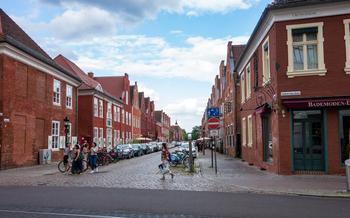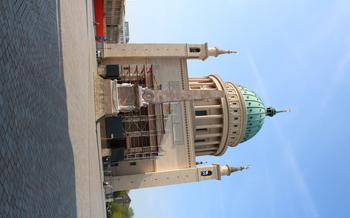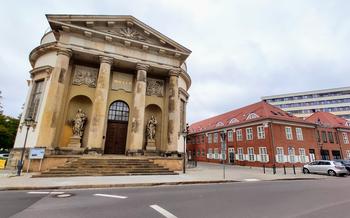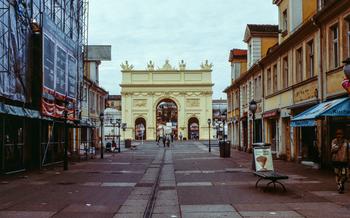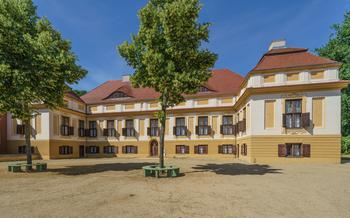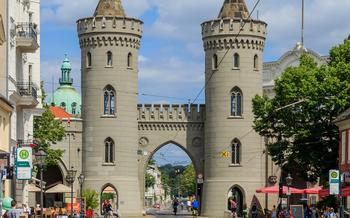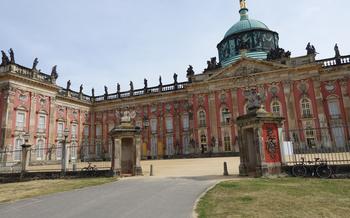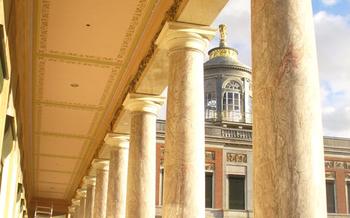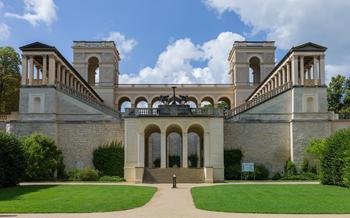
The Jan Bouman House (Haus Jan Bouman)
- Immerse into Potsdam's Dutch Quarter: Exploring the Jan Bouman House
- Historical Significance: A Legacy of Dutch Influence
- Architectural Marvel: A Blend of Styles
- Interior Exploration: Uncovering Hidden Treasures
- Cultural Heritage: Preserving a Legacy
- Exhibitions and Events: A Dynamic Cultural Venue
- Guided Tours: Unveiling Hidden Stories
- Workshops and Activities: Interactive Cultural Experiences
- Souvenir Shop: Mementos of a Unique Visit
- Accessibility: Welcoming All Visitors
- Location and Transportation: Getting There with Ease
- Nearby Attractions: Exploring Potsdam's Treasures
- Planning Your Visit: Tips for a Rewarding Experience
- Photography and Videography: Capturing Memorable Moments
- Insider Tip: Unveiling a Hidden Gem
Immerse into Potsdam's Dutch Quarter: Exploring the Jan Bouman House
Nestled in the heart of Potsdam's historic Dutch Quarter, the Jan Bouman House stands as a testament to the city's rich cultural heritage. Built in 1739 by Jan Bouman, a wealthy Dutch merchant, the house played a pivotal role in the development of the quarter and the city as a whole. As one of the earliest examples of Dutch architecture in Potsdam, the Jan Bouman House showcases a unique blend of Dutch and Prussian influences, reflecting the close ties between the two countries during the 18th century. Today, the house serves as a cultural heritage site, inviting visitors to step back in time and explore the fascinating stories of the Bouman family and the Dutch community that shaped Potsdam's history.
Historical Significance: A Legacy of Dutch Influence
The history of Potsdam's Dutch Quarter is deeply intertwined with the reign of Frederick William I, also known as the "Soldier King," who ascended to the throne in 17Recognizing the importance of skilled labor and trade, the king actively recruited Dutch artisans, craftsmen, and merchants to settle in Potsdam. Among the most prominent figures who heeded his call was Jan Bouman, a successful merchant and entrepreneur.
Bouman played a pivotal role in shaping the development of the Dutch Quarter, which became an integral part of Potsdam's urban fabric. The neighborhood showcased the unique blend of Dutch and Prussian architectural styles, reflecting the city's cosmopolitan character. Bouman's house, constructed in 1738, stands as a testament to his contributions and serves as a symbol of the enduring legacy of Dutch influence in Potsdam.
The Jan Bouman House epitomizes the strong ties between the Netherlands and Prussia during the 18th century. It is a tangible reminder of the significant contributions made by Dutch immigrants to the growth and prosperity of Potsdam. Their expertise in various fields, including construction, trade, and manufacturing, helped transform the city into a thriving cultural and economic hub.
Architectural Marvel: A Blend of Styles
The Jan Bouman House stands as a testament to the fusion of Dutch and Prussian architectural styles. Constructed in 1733, the house showcases a unique blend of traditional Dutch elements, such as the stepped gable and the use of red bricks, with Prussian influences seen in the symmetrical facade and the elegant proportions.
The exterior of the house is adorned with intricate carvings and decorative elements, reflecting the craftsmanship and attention to detail that went into its construction. The interior spaces feature a harmonious mix of Dutch and Prussian design, with grand staircases and intricately painted ceilings.
The Jan Bouman House is a remarkable example of the cultural exchange that took place between the Netherlands and Prussia during the 18th century. Its architectural features not only reflect the influence of Dutch immigrants but also symbolize the harmonious coexistence of different cultures in Potsdam.
The house's design is a testament to the skill of its architect, Jan Bouman, who successfully integrated elements from both Dutch and Prussian traditions to create a cohesive and visually appealing masterpiece. It stands as a valuable contribution to the architectural heritage of Potsdam and continues to captivate visitors with its unique blend of styles.
Interior Exploration: Uncovering Hidden Treasures
The Jan Bouman House is not merely a historical monument but a treasure trove of architectural and artistic wonders that await exploration. Step inside, and you will be greeted by a captivating layout that showcases the fusion of Dutch and Prussian design elements. The grand staircase, a masterpiece in itself, commands attention with its intricate carvings and elegant balustrade. As you ascend, admire the stunning ceiling paintings that adorn the walls, depicting scenes from Dutch history and mythology.
The interior spaces are a testament to the meticulous craftsmanship and attention to detail that went into the construction of this remarkable building. Each room features unique elements that reflect the diverse influences that shaped Potsdam's Dutch Quarter. From the ornate fireplaces to the delicate moldings, every corner reveals a hidden gem that adds to the house's charm and allure.
Take a moment to appreciate the authentic materials used throughout the house. The rich wood paneling, the gleaming marble floors, and the hand-blown glass chandeliers contribute to the sense of grandeur and opulence. These carefully selected materials not only enhance the aesthetic appeal of the house but also speak to the enduring legacy of the Dutch artisans who left their mark on Potsdam.
Cultural Heritage: Preserving a Legacy
The Jan Bouman House stands as a testament to the rich cultural heritage of Potsdam and the enduring influence of Dutch immigrants on the city's development. Recognizing its exceptional significance, concerted efforts have been undertaken to preserve and restore this architectural gem to its former glory.
Skilled craftsmen and artisans have meticulously worked to restore the building's original features, ensuring that the intricate details and unique characteristics of the Jan Bouman House are maintained for generations to come. The restoration process involved careful attention to every aspect of the house, from the intricate carvings on the façade to the delicate ceiling paintings within.
Beyond its physical preservation, the Jan Bouman House serves as a vital platform for promoting cultural awareness and education. It hosts a variety of exhibitions, workshops, and events that delve into the history and traditions of the Dutch Quarter and the broader cultural exchange between the Netherlands and Prussia.
Through these initiatives, the Jan Bouman House plays a crucial role in fostering a deeper understanding and appreciation of the city's diverse cultural heritage. It invites visitors to explore the unique contributions of Dutch immigrants to Potsdam's development and to gain insights into the vibrant cultural interactions that shaped the city's identity.
Exhibitions and Events: A Dynamic Cultural Venue
The Jan Bouman House is not merely a static museum but a vibrant cultural venue that hosts a diverse range of exhibitions and events throughout the year. These events are meticulously curated to showcase Dutch culture, history, and contemporary art, creating a dynamic and engaging space for visitors.
Exhibitions at the Jan Bouman House delve into various aspects of Dutch culture, from traditional crafts and design to historical milestones and contemporary artistic expressions. These exhibitions provide a platform for both established and emerging Dutch artists to share their work with a broader audience, fostering cultural exchange and promoting mutual understanding.
In addition to exhibitions, the Jan Bouman House regularly hosts events that bring the Dutch community together and engage visitors from all walks of life. These events include workshops, lectures, concerts, and film screenings, offering a unique opportunity to experience Dutch culture firsthand.
Whether it's a thought-provoking exhibition, an energetic concert, or a hands-on workshop, the events at the Jan Bouman House offer visitors a chance to immerse themselves in Dutch culture, learn about its rich history, and appreciate its vibrant contemporary expressions. These events transform the Jan Bouman House into a living, breathing testament to the enduring legacy of Dutch influence in Potsdam.
Guided Tours: Unveiling Hidden Stories
The Jan Bouman House offers guided tours in various languages, providing visitors with an immersive and informative experience. Knowledgeable guides lead visitors through the house's grand rooms, sharing captivating stories and anecdotes about its history, architecture, and cultural significance. Visitors can delve deeper into the lives of the Bouman family and other notable figures associated with the house. The guides provide insights into the unique Dutch-Prussian heritage of Potsdam and the role of the Bouman family in shaping the city's development.
By participating in a guided tour, visitors can gain a deeper understanding of the Jan Bouman House's significance as a cultural heritage site. The guides highlight the intricate details of the house's architecture, furnishings, and artwork, bringing the past to life. Visitors can ask questions and engage in discussions, creating a dynamic and interactive learning experience.
Whether you're a history buff, an architecture enthusiast, or simply curious about the stories behind the Jan Bouman House, a guided tour is an excellent way to enhance your visit. It's an opportunity to uncover hidden stories, gain exclusive insights, and leave with a newfound appreciation for this architectural gem.
Workshops and Activities: Interactive Cultural Experiences
The Jan Bouman House offers a variety of workshops and activities that allow visitors to immerse themselves in Dutch culture and history. These interactive experiences provide a unique opportunity to learn new skills and create lasting memories.
One popular workshop is the Delftware painting workshop. Participants learn the traditional techniques of painting Delftware, a type of blue and white pottery that originated in the Netherlands. They can choose from a variety of designs and create their own unique piece of Delftware to take home.
Another popular activity is the clog-making workshop. Participants learn how to make traditional wooden clogs, a type of footwear that is still worn in the Netherlands today. They can choose from a variety of colors and styles and create their own pair of clogs to wear or display.
The Jan Bouman House also offers a variety of other workshops and activities, such as cheese-making workshops, tulip-arranging workshops, and Dutch cooking classes. These activities are a great way to learn more about Dutch culture and traditions and to have some fun at the same time.
Souvenir Shop: Mementos of a Unique Visit
The Jan Bouman House offers a unique souvenir shop where visitors can find a treasure trove of mementos to commemorate their visit and take a piece of Dutch culture home with them. The shop is a treasure trove of unique and authentic items inspired by the history and culture of the Netherlands. From traditional Dutch handicrafts to replicas of historical artifacts, visitors can find a wide range of souvenirs to suit every taste and budget.
The souvenir shop is a great place to find gifts for friends and family, or to simply treat yourself to a special keepsake. Whether you're looking for a traditional Dutch windmill figurine, a Delft blue pottery piece, or a book on Dutch history, you're sure to find something to your liking. The shop also offers a variety of postcards, magnets, and other small items that are perfect for sending to loved ones back home.
By purchasing a souvenir from the Jan Bouman House, you not only take home a memento of your visit but also support the ongoing preservation and maintenance of this historic landmark. The revenue generated from the souvenir shop helps to fund important restoration projects and educational programs, ensuring that future generations can continue to enjoy and learn from this unique piece of Dutch heritage.
Accessibility: Welcoming All Visitors
The Jan Bouman House is committed to ensuring that all visitors can enjoy its offerings, regardless of their abilities. Accessibility features have been carefully considered and implemented throughout the building to create an inclusive environment for all.
Visitors with disabilities can easily access the Jan Bouman House through ramps and elevators. The main entrance is equipped with an automatic door opener, and there are accessible restrooms located on each floor. The museum's staff is also trained to assist visitors with disabilities and provide any necessary accommodations.
The Jan Bouman House's commitment to accessibility extends beyond physical features. The museum offers a variety of programs and services designed to make the experience more enjoyable for visitors with disabilities. Guided tours are available in sign language, and there are audio guides that provide detailed descriptions of the exhibits. The museum also offers tactile exhibits and workshops that allow visitors to experience the history and culture of the Dutch Quarter through touch.
By creating an accessible environment, the Jan Bouman House ensures that everyone can learn about and appreciate the rich history and culture of the Dutch Quarter. The museum's commitment to inclusion makes it a welcoming and enjoyable destination for visitors of all abilities.
Location and Transportation: Getting There with Ease
Situated in the heart of Potsdam, the Jan Bouman House enjoys an enviable location that makes it easily accessible by various means of transportation. Its proximity to public transportation hubs, including bus and tram stops, ensures that visitors can conveniently reach the site without the hassle of traffic congestion. For those arriving by car, ample parking options are available in the vicinity, providing a stress-free arrival experience. Whether you choose to navigate the city's streets or utilize public transportation, the Jan Bouman House is effortlessly accessible, allowing you to seamlessly integrate your visit into your exploration of Potsdam's many wonders.
Nearby Attractions: Exploring Potsdam's Treasures
The Jan Bouman House is strategically located in the heart of Potsdam, surrounded by an array of captivating attractions that await exploration. A short stroll from the house, visitors can immerse themselves in the splendor of the Sanssouci Palace, a UNESCO World Heritage Site renowned for its opulent rococo architecture and picturesque gardens. This former summer palace of Frederick the Great offers a glimpse into the lavish lifestyle of Prussian royalty.
Another must-see attraction is the Brandenburg Gate, an iconic symbol of Potsdam's rich history. Erected in the 18th century, this magnificent gate served as a triumphal arch commemorating Prussia's military victories. Today, it stands as a symbol of unity and reconciliation, inviting visitors to explore the vibrant city beyond.
For those seeking a tranquil retreat, the idyllic Babelsberg Park provides a welcome respite from the urban hustle and bustle. This sprawling park, situated on the banks of the Havel River, boasts enchanting gardens, serene lakes, and picturesque walking trails. Visitors can meander through its lush landscapes, admire the architectural wonders that dot the park, or simply relax and soak in the tranquility of nature.
Potsdam offers a harmonious blend of history, culture, and natural beauty, ensuring that visitors to the Jan Bouman House have an array of captivating experiences to choose from. Whether exploring the grandeur of royal palaces, marveling at architectural masterpieces, or seeking solace in tranquil parks, Potsdam promises an unforgettable journey through time and history.
Planning Your Visit: Tips for a Rewarding Experience
To make the most of your visit to the Jan Bouman House, careful planning is essential. Here are a few tips to ensure a rewarding and memorable experience:
Choose the Right Time: The best time to visit the Jan Bouman House is during the shoulder seasons (spring or autumn) when the weather is pleasant, and the crowds are smaller. This will allow you to explore the house and its surroundings at a more relaxed pace.
Plan the Duration: Allow at least one to two hours for your visit to fully appreciate the Jan Bouman House's architectural features, explore the exhibitions, and delve into its rich history. If you're particularly interested in Dutch culture or history, you may want to allocate more time to explore the house's extensive collection.
Consider a Guided Tour: Guided tours are available in various languages and offer a deeper insight into the history and significance of the Jan Bouman House. Booking a guided tour in advance is recommended, especially during peak tourist seasons, to secure a spot and avoid disappointment.
Respect the House and Its Visitors: Remember that the Jan Bouman House is a historical monument and a place of cultural significance. Be respectful of the house and its artifacts, and maintain a quiet and considerate demeanor during your visit.
Capture Your Memories: Photography and videography are generally permitted inside the Jan Bouman House, but flash photography is not allowed to preserve the integrity of the artifacts. Please be mindful of other visitors and avoid capturing them in your photos or videos without their consent.
Photography and Videography: Capturing Memorable Moments
Photography and videography are permitted inside the Jan Bouman House, allowing visitors to capture their memories of this unique cultural heritage site. However, it is essential to abide by the following guidelines:
-
Respect for Artifacts: Visitors must exercise caution when taking photos or videos near delicate artifacts or exhibits. Using flash photography is prohibited to prevent damage to these precious items.
-
Privacy of Others: Visitors should be mindful of other guests and avoid taking photos or videos that may intrude on their privacy. It is important to respect the personal space of others and seek permission before photographing individuals.
-
Preservation of Heritage: The Jan Bouman House is a valuable cultural heritage site, and visitors are responsible for preserving its integrity. Damaging or altering any part of the building or its contents is strictly prohibited.
By following these guidelines, visitors can capture their memories of the Jan Bouman House while respecting its historical significance and the privacy of others.
Insider Tip: Unveiling a Hidden Gem
Beyond the Jan Bouman House itself, the Dutch Quarter holds a secret gem that often goes unnoticed: the Dutch Cemetery. Located just a short walk from the house, this tranquil sanctuary offers a glimpse into the lives of the Dutch community that once thrived in Potsdam. Stroll through the rows of weathered tombstones, each telling a unique story of immigration, assimilation, and the enduring legacy of Dutch influence in the city. Take a moment to reflect on the contributions of these early settlers and the rich cultural heritage they left behind.
